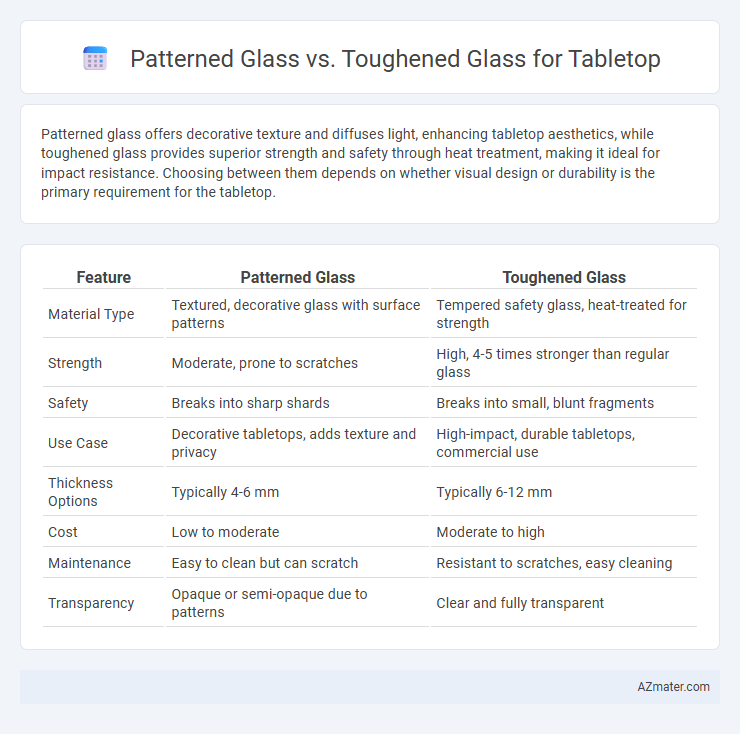Patterned glass offers decorative texture and diffuses light, enhancing tabletop aesthetics, while toughened glass provides superior strength and safety through heat treatment, making it ideal for impact resistance. Choosing between them depends on whether visual design or durability is the primary requirement for the tabletop.
Table of Comparison
| Feature | Patterned Glass | Toughened Glass |
|---|---|---|
| Material Type | Textured, decorative glass with surface patterns | Tempered safety glass, heat-treated for strength |
| Strength | Moderate, prone to scratches | High, 4-5 times stronger than regular glass |
| Safety | Breaks into sharp shards | Breaks into small, blunt fragments |
| Use Case | Decorative tabletops, adds texture and privacy | High-impact, durable tabletops, commercial use |
| Thickness Options | Typically 4-6 mm | Typically 6-12 mm |
| Cost | Low to moderate | Moderate to high |
| Maintenance | Easy to clean but can scratch | Resistant to scratches, easy cleaning |
| Transparency | Opaque or semi-opaque due to patterns | Clear and fully transparent |
Introduction to Glass Options for Tabletops
Patterned glass for tabletops offers decorative textures and privacy while diffusing light to create a unique aesthetic, ideal for enhancing interior design. Toughened glass provides exceptional strength and safety through a heat treatment process, making it resistant to impacts and thermal stress. Choosing between patterned and toughened glass depends on whether the priority is visual texture and design or enhanced durability and safety.
What is Patterned Glass?
Patterned glass for tabletops features embossed or textured surfaces that enhance visual appeal while providing privacy and hiding fingerprints or smudges. It differs from toughened glass, which is chemically or thermally strengthened for superior impact resistance and safety. Patterned glass offers aesthetic variety and moderate durability, making it ideal for decorative tabletops where visual texture is prioritized over heavy-duty strength.
What is Toughened Glass?
Toughened glass, also known as tempered glass, is a type of safety glass processed through controlled thermal or chemical treatments to increase its strength compared to normal glass. This makes it highly resistant to impacts and temperature changes, ideal for tabletops requiring durability and safety. Patterned glass, on the other hand, features decorative textures but lacks the enhanced strength and safety properties of toughened glass.
Design Aesthetics: Patterned vs Toughened Glass
Patterned glass offers unique design aesthetics through its textured surfaces, adding depth and visual interest to tabletops while diffusing light and obscuring visibility for enhanced privacy. Toughened glass provides a sleek, smooth, and clear finish that emphasizes modern minimalism and enhances the perception of space, perfect for showcasing underlying materials or decorative elements. Both types enhance durability, but patterned glass stands out for artistic appeal, whereas toughened glass excels in contemporary, clean design styles.
Strength and Durability Comparison
Toughened glass, also known as tempered glass, offers superior strength and impact resistance compared to patterned glass, making it ideal for tabletops subjected to heavy use or potential impacts. Patterned glass, while providing aesthetic appeal through textured or frosted designs, generally lacks the enhanced durability and shatter resistance of toughened glass. Selecting toughened glass for tabletops ensures enhanced safety and longevity due to its ability to withstand greater stress and resist breakage under pressure.
Safety Features and Considerations
Patterned glass offers decorative appeal with moderate impact resistance but lacks the high safety standards ideal for tabletops subjected to heavy use. Toughened glass undergoes a thermal or chemical strengthening process, making it up to five times stronger than standard glass and resistant to shattering, which significantly reduces the risk of injury in case of breakage. For safety-focused tabletop applications, toughened glass is preferred due to its durability, controlled fragmenting properties, and compliance with safety regulations such as ANSI Z97.1 and EN 12150.
Maintenance and Cleaning Differences
Patterned glass tabletops often require careful cleaning to avoid dirt buildup in textured grooves, using soft cloths and mild detergents to prevent scratches and maintain clarity. Toughened glass, being smooth and laminated, allows easier maintenance with standard glass cleaners, offering higher resistance to impact and thermal stress. Both types benefit from regular dusting, but patterned glass demands more frequent deep cleaning to preserve its aesthetic appeal.
Cost Analysis: Patterned Glass vs Toughened Glass
Patterned glass typically costs less than toughened glass due to its simpler manufacturing process and lower strength specifications. Toughened glass involves heat treatment to increase durability and safety, resulting in higher production costs and a premium price for tabletops requiring enhanced impact resistance. Evaluating these cost differences helps determine the optimal glass type for budget-conscious projects that balance aesthetics with functional strength.
Best Use Cases for Each Glass Type
Patterned glass is ideal for tabletops requiring decorative privacy and textured surfaces, such as in dining rooms or office partitions, where aesthetic appeal and light diffusion are priorities. Toughened glass is best suited for high-impact areas like kitchen counters or outdoor tabletops, providing enhanced safety and durability through its heat-treated strength. Selecting the appropriate glass type depends on balancing design preference with functional needs, where patterned glass excels in style and toughened glass in resilience.
Choosing the Right Glass for Your Tabletop
When choosing the right glass for your tabletop, patterned glass offers decorative appeal with unique textures and designs that can hide fingerprints and smudges, making it ideal for aesthetic-focused spaces. Toughened glass, also known as tempered glass, provides enhanced strength and safety by resisting impact and breaking into small, less harmful pieces, suited for high-traffic areas or homes with children. Consider the balance between visual style and durability to select the glass that best fits your lifestyle and functional needs.

Infographic: Patterned glass vs Toughened glass for Tabletop
 azmater.com
azmater.com